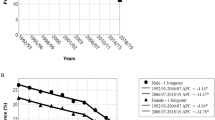Abstract
Smoking is an expensive habit. Smoking households spend, on average, more than $US1000 annually on cigarettes. When a family member quits, in addition to the former smoker’s improved long-term health, families benefit because savings from reduced cigarette expenditures can be allocated to other goods. For households in which some members continue to smoke, smoking expenditures crowd-out other purchases, which may affect other household members, as well as the smoker. We empirically analyse how expenditures on tobacco crowd-out consumption of other goods, estimating the patterns of substitution and complementarity between tobacco products and other categories of household expenditure. We use the Consumer Expenditure Survey data for the years 1995–2001, which we complement with regional price data and state cigarette prices. We estimate a consumer demand system that includes several main expenditure categories (cigarettes, food, alcohol, housing, apparel, transportation, medical care) and controls for socioeconomic variables and other sources of observable heterogeneity. Descriptive data indicate that, comparing smokers to nonsmokers, smokers spend less on housing. Results from the demand system indicate that as the price of cigarettes rises, households increase the quantity of food purchased, and, in some samples, reduce the quantity of apparel and housing purchased.






Similar content being viewed by others
Notes
1Representative items in the expenditure categories include food (food at home, food away from home), housing (rent, mortgage interest, property taxes, maintenance and repairs, utilities, household operations, house furnishings), apparel (men’s, boys’, women’s and girls’ apparel; footwear; other apparel services), transportation (vehicle purchases [both new and used], gas, motor oil, vehicle finance charges, insurance, repairs, vehicle rentals) and healthcare (health insurance, medical supplies, medical services, prescription drugs). For further specific classifications, see US Department of Labor, Bureau of Labor Statistics.[13]
2Low income is defined as less than 200% of the US federal poverty line.
3In work currently in progress, we are exploiting the longitudinality of the dataset and controlling for the correlation of the error terms over time.
4Note that given the formula for the elasticities, we can obtain their variances (and statistical level of significance) as a linear combination of the variances of the estimated coefficients.
5For example, when we estimated the model including the selection bias correction terms, the own price elasticity of tobacco in the full sample was −0.977, compared with −0.986 when we did not include them.
References
Congressional Budget Office. Federal taxation of tobacco, alcoholic beverages, and motor fuels. Washington, DC: US Government Printing Office, 1990
Chaloupka FJ, Warner KE. The economics of smoking. In: Culyer AJ, Newhouse JP, editors. Handbook of health economics. Vol. 1B. Amsterdam: Elsevier Science, 2000: 1539–627
From the Centers for Disease Control and Prevention. Response to increases in cigarette prices by race/ethnicity, income, and age groups — United States, 1976–1993. JAMA 1998; 280(23): 1979–80
Remler DK. Poor smokers, poor quitters, and cigarette tax regressivity. Am J Public Health 2004 Feb; 94(2): 225
Barrow L, McGranahan L. The earned income credit and durable goods purchases. Evanston (IL): The Joint Center for Poverty Research Conference on the Earned Income Tax Credit, 1999
Souleies NS. The response of household consumption to income tax refunds. Am Econ Rev 1999; 89(4): 947–58
Deaton AS, Muellbauer J. An almost ideal demand system. Am Econ Rev 1980; 70(3): 312–26
Deaton A, Muellbauer J. Economics and consumer behavior. Cambridge (UK): Cambridge University Press, 1980
Hunt-McCool J, Kiker BF, Ng YC. Estimates of the demand for medical care under different functional forms. J Appl Econom 1994; 9(2): 201–18
Jones AM. A systems approach to the demand for alcohol and tobacco. Bull Econ Res 1989 Apr; 41(2): 85–105
World Health Organization. Tobacco and poverty: a vicious circle. Geneva: World Health Organization, 2004
Mackay J, Eriksen M. The tobacco atlas. Geneva: World Health Organization, 2002: 22–3, 30-1
US Department of Labor, Bureau of Labor Statistics. Consumer Expenditure Survey, 2002: interview survey and detailed expenditure files [computer file; ICPSR03949-v1]. Ann Arbor (MI): Inter-university Consortium for Political and Social Research [distributor], 2005 Mar 25
Centers for Disease Control and Prevention, Division of Adult and Community Health, National Center for Chronic Disease Prevention and Health Promotion. Behavioral risk factor surveillance system, prevalence data (1995–2002) [online]. Available from URL: http://apps.nccd.cdc.gov/brfss/ [Accessed 2005 Mar 31]
Bien TH, Bürge R. Smoking and drinking: a review of the literature. Int J Addict 1990; 25(12): 1429–31
Evans WN, Farrelly MC. The compensating behavior of smokers: taxes, tar and nicotine. Rand J Econ 1998; 29(3): 578–95
DeGrandpre RJ, Bickel WK. Human drug self administration in a medium of exchange. Exp Clin Psychopharmacol 1995; 3: 349–57
Ohsfeldt RL, Boyle RG, Capilouto EI. Tobacco taxes, smoking restrictions, and tobacco use. In: Chaloupka FJ, Grossman M, Bickel WK, et al., editors. The economic analysis of substance use and abuse: an integration of econometric and behavioral economic research. Chicago: University of Chicago Press, 1999
Klesges RC, Meyers AW, Klesges LM, et al. Smoking, body weight, and their effects on smoking behavior: a comprehensive review of the literature. Psychol Bull 1989; 106(2): 204–30
Acknowledgements
We would like to acknowledge financial support from the Robert Wood Johnson Foundation (#039787) and the National Institute on Drug Abuse (NIDA RO1-DA14471). We also thank Frank Chaloupka for providing ciga-rette price data and Meg Wise for programming assistance. ## The authors have provided no information on conflicts of interest directly relevant to the content of this article.
Author information
Authors and Affiliations
Corresponding author
Rights and permissions
About this article
Cite this article
Busch, S.H., Jofre-Bonet, M., Falba, T.A. et al. Burning a hole in the budget. Appl Health Econ Health Policy 3, 263–272 (2004). https://doi.org/10.2165/00148365-200403040-00009
Published:
Issue Date:
DOI: https://doi.org/10.2165/00148365-200403040-00009




